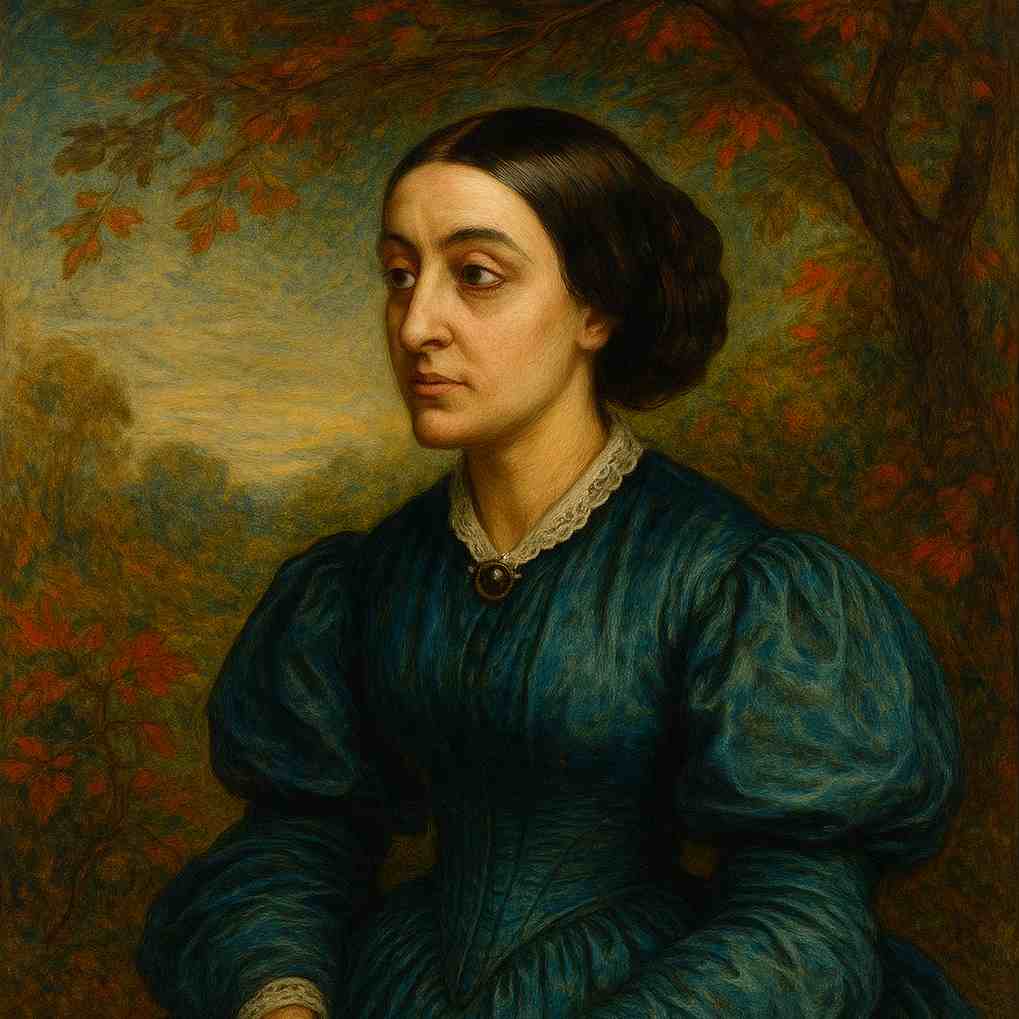Twice
Christina Rossetti
1830 to 1894

I took my heart in my hand
(O my love, O my love),
I said: Let me fall or stand,
Let me live or die,
But this once hear me speak
(O my love, O my love);
Yet a woman's words are weak:
You should speak, not I.
You took my heart in your hand
With a friendly smile,
With a critical eye you scanned,
Then set it down,
And said: It is still unripe,
Better wait awhile;
Wait while the skylarks pipe,
Till the corn grows brown.
As you set it down it broke,--
Broke, but I did not wince;
I smiled at the speech you spoke,
At your judgment that I heard:
But I have not often smiled
Since then, nor questioned since,
Nor cared for corn-flowers wild,
Nor sung with the singing bird.
I take my heart in my hand,
O my God, O my God,
My broken heart in my hand:
Thou hast seen, judge Thou.
My hope was written on sand,
O my God, O my God;
Now let Thy judgment stand,--
Yea, judge me now.
This contemned of a man,
This marred one heedless day,
This heart take Thou to scan
Both within and without:
Refine with fire its gold,
Purge Thou its dross away,--
Yea, hold it in Thy hold,
Whence none can pluck it out.
I take my heart in my hand,--
I shall not die, but live,--
Before Thy face I stand;
I, for Thou callest such:
All that I have I bring,
All that I am I give,
Smile Thou and I shall sing,
But shall not question much.
Christina Rossetti's Twice
Christina Rossetti's poem "Twice" is a poignant exploration of heartbreak, resilience, and spiritual redemption. Through its intricate structure and emotive language, Rossetti crafts a narrative that moves from human love to divine solace, illustrating the speaker's journey from vulnerability to strength.
The poem is structured in five stanzas, each with eight lines, following an ABCBDBEB rhyme scheme. This consistent form provides a sense of order and progression to the emotional turbulence described within. The repetition of the phrase "I took my heart in my hand" at the beginning of the first, fourth, and fifth stanzas serves as a refrain, marking significant shifts in the speaker's emotional state and the object of her address.
In the first stanza, the speaker presents her heart to a lover, emphasizing her vulnerability with parenthetical interjections of "O my love." The line "Let me fall or stand" illustrates the speaker's willingness to accept any outcome, highlighting the intensity of her emotions. However, she immediately undermines her own plea by stating, "Yet a woman's words are weak," reflecting the societal constraints and gender expectations of Rossetti's Victorian era.
The second stanza shifts perspective, describing the lover's response. The use of words like "friendly" and "critical" creates a juxtaposition that hints at the lover's ultimate rejection. The metaphor of unripe fruit suggests that the lover views the speaker's affections as premature or underdeveloped. The advice to "wait while the skylarks pipe, / Till the corn grows brown" employs natural imagery to convey the passage of time and the potential for emotional maturation.
The third stanza reveals the devastating impact of the rejection. The speaker's heart "broke" upon being set down, yet she maintains a facade of composure, smiling at the lover's words. The subsequent lines, however, reveal the long-lasting effects of this rejection: the speaker has rarely smiled since, lost interest in nature's beauty (symbolized by "corn-flowers wild"), and no longer sings. This stanza effectively captures the numbing effect of heartbreak and the loss of joy in once-cherished experiences.
A significant shift occurs in the fourth stanza as the speaker turns to God, repeating the opening line but replacing "O my love" with "O my God." This marks a transition from earthly to divine love. The speaker presents her "broken heart" to God for judgment, acknowledging the futility of her previous hopes, which were "written on sand." This imagery evokes the biblical parable of building on sand versus rock, suggesting that the speaker now seeks a more stable foundation for her emotional and spiritual life.
The final stanza continues the address to God, asking Him to examine and refine her heart. The use of metallurgical imagery - "Refine with fire its gold, / Purge Thou its dross away" - alludes to the purification process of precious metals, symbolizing the speaker's desire for spiritual cleansing and transformation. The stanza concludes with a declaration of faith and submission to God's will, echoing biblical language: "I shall not die, but live."
Throughout the poem, Rossetti employs a range of literary devices to enhance its emotional impact. The use of anaphora, particularly with the repeated phrase "I take my heart in my hand," creates a sense of ritual and emphasizes the speaker's agency in her emotional journey. The consistent use of natural imagery - skylarks, corn, flowers - contrasts the organic, cyclical nature of the natural world with the abruptness of human emotional experiences.
Thematically, "Twice" explores the transition from human to divine love, the resilience of the human spirit in the face of rejection, and the redemptive power of faith. The poem can be read as a critique of the limitations of earthly love and the societal constraints placed on women's emotional expression in Rossetti's time. It also reflects the influence of Rossetti's devout Christianity, presenting spiritual devotion as a source of strength and renewal after earthly disappointments.
In conclusion, "Twice" is a masterful exploration of love, loss, and spiritual redemption. Through its structured form, evocative imagery, and emotional depth, Rossetti creates a powerful narrative of personal growth and faith. The poem not only reflects the social and religious context of its time but also speaks to universal experiences of heartbreak and the human quest for meaning and healing.
This text was generated by AI and is for reference only. Learn more
Want to join the discussion? Reopen or create a unique username to comment. No personal details required!



Comments
No comments yet. Be the first to comment!